Montenegrins of Serbia
The Montenegrins of Serbia (Serbian: Црногорци у Србији, romanized: Crnogorci u Srbiji) are a national minority in the country. According to the 2011 census, there are 38,527[2] ethnic Montenegrins in Serbia. They are the sixth largest ethnic community in the Vojvodina province.
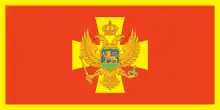 Flag of the National Council of the Montenegrin Minority in Serbia | |
| Total population | |
|---|---|
| 38,527 (2011) | |
| Regions with significant populations | |
| 22,141 (1.15%) | |
| 9,902 | |
| Languages | |
| Serbian or Montenegrin[1] | |
| Religion | |
| Eastern Orthodoxy | |
| Related ethnic groups | |
| Serbs | |
Geography
The largest concentration of Montenegrins in Vojvodina could be found in the municipalities of Vrbas (24.79%), Mali Iđoš (20.83%), and Kula (16.34%). Settlements in Vojvodina with an absolute or relative Montenegrin majority are: Lovćenac in the Mali Iđoš municipality with 56.86% Montenegrins, Kruščić in the Kula municipality with 32.64%, and Montenegrins in Savino Selo in the Vrbas municipality with 38.20% Montenegrins. Formerly, the village of Bačko Dobro Polje in the Vrbas municipality also had a Montenegrin majority (According to the 1971 census, Montenegrins comprised 55.39% of population of this village, while according to the 2002 census, the current population of the village is composed of 57.17% Serbs and 38.18% Montenegrins. Also, Montenegrins in Sivac in the Kula municipality had a Montenegrin majority in the 1970's, now they have a sizable minority population of 30.06% according to the 2002 census.
Demographics

| Part of a series on |
| Montenegrins |
|---|
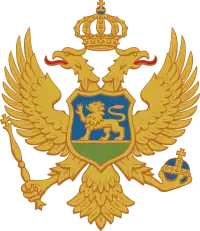 |
| By region or country |
| Recognized populations |
|
Montenegro Serbia Bosnia and Herzegovina Croatia North Macedonia Kosovo Albania |
| Diaspora |
|
Europe · Austria · Denmark France · Germany Italy · Luxembourg Russia · Slovenia Sweden · Switzerland United Kingdom |
|
North America United States · Canada · Mexico |
|
South America Argentina · Chile Bolivia · Brazil · Colombia |
|
Oceania Australia · New Zealand |
| Culture |
|
Literature · Music · Art · Cinema Cuisine · Dress · Sport |
| Religion |
|
Catholicism Islam |
| Language and dialects |
| Montenegrin · Serbian |
| History |
|
History of Montenegro Rulers |
| Year | Montenegrins | % |
|---|---|---|
| 1948 | 74,860 | 1.15% |
| 1953 | 86,061 | 1.23% |
| 1961 | 104,753 | 1.37% |
| 1971 | 125,260 | 1.48% |
| 1981 | 147,466 | 1.58% |
| 1991 | 139,299 | 1.42% |
| 1991 (excl. Kosovo) | 118,934 | 1.52% |
| 2002 (excl. Kosovo) | 69,049 | 0.92% |
| 2011 (excl. Kosovo) | 38,527 | 0.5% |
In Vojvodina, the number of Montenegrins, according to 1948-2011 censuses: 1948: 30,589 (1.9%); 1953: 30,516 (1.8%); 1961: 34,782 (1.9%); 1971: 36,416 (1.9%); 1981: 43,304 (2.1%); 1991: 47,289 (2.3%); 2002: 35,513 (1.75%); 2011: 22,141 (1.15%).
Culture
Montenegrins in Serbia speak Montenegrin and the vast majority are adherents of the Serbian Orthodox Church. The society of Montenegrins in Serbia, known as "Krstaš", is based in Lovćenac. Montenegrin language was recognised as minority language in official use in Mali Iđoš.[3]
Notable people
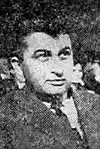 | 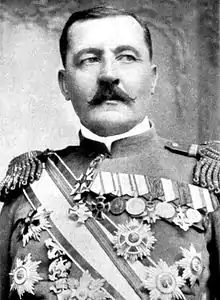 | 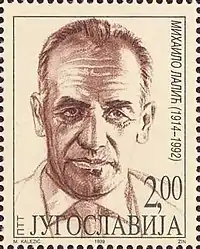 |
- Politics
- Žarko Bulajić, former president of the Presidency of the Socialist Republic of Montenegro, born in Nikšić
- Vidoje Žarković, former president of the People's Assembly of the Socialist Republic of Montenegro, born in Plužine
- Borislav Milošević, diplomat who last served as Yugoslav ambassador to Algeria, Japan and Russia
- Budislav Šoškić, former president of the People's Assembly of the Socialist Republic of Montenegro, born in Novi Pazar
- Ljubomir Tadić, academic and politician born in Smriječno village near Plužine
- Slobodan Milošević, former president of Serbia and president of Yugoslavia
- Military
- Janko Vukotić, serdar
- Literature
- Mihailo Lalić, novelist
- Other
- Filip Kapisoda, model and handball player
- Petar Škuletić, football player
- Staniša Mandić, football player
Sources
- "Nacionalni savjet crnogorske nacionalne manjine".
- http://popis2011.stat.rs/?lang=en
- B92: Crnogorski jezik u Malom Iđošu (Montenegrin language in Mali Iđoš) (in Serbian)
